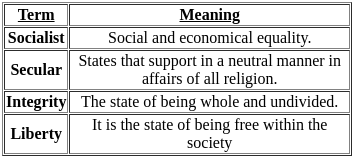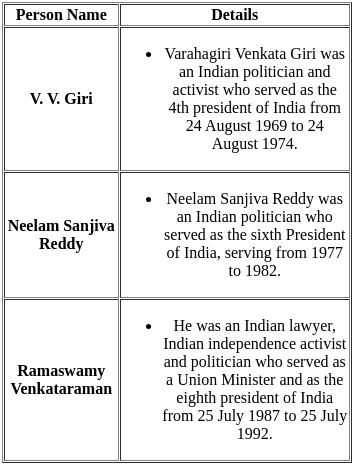Political Science: CUET Mock Test - 6 - CUET MCQ
30 Questions MCQ Test CUET UG Mock Test Series 2026 - Political Science: CUET Mock Test - 6
Who among the following were the founders of the "Hind Mazdoor Sabha" established in 1948?
Which of the following words were added to the Preamble after the 42nd Amendment Act?
Who was the first president of India who declared a national emergency in 1975?
Which of the following party was founded by Shri Jayaprakash Narayan in the year 1977?
The emergency declared by Indira Gandhi in 1975 comes under the purview of:
Which treaty between United States and Soviet Union signed in 1972, tried to stop using missiles as a defensive shield to launch a nuclear attack?
The Backward and Minority Communities Employees Federation (BAMCEF) was formed in the year:
The Rio Summit produced conventions dealing with climate change, biodiversity, forestry, and recommended a list of developments practices is called:
The first non-aligned summit was held in ______ in 1961
Which factors did not lead to the first summit of NAM?
Choose the correct statement from the following with regards to the paragraph
Arrange in chronological order of their coming into existence.
A. Council of Europe
B. Organisation for European Economic Cooperation
C. European Union
D. European Economic Community
For the revival of the European economies after the Second World War, the United States of America extended financial aid under:
Which of the following was not an initial objective of the European Union?
Match List I with List II

Choose the correct answer from the options given below:
Which of the following statements are correct with regard to the European Union(EU)?
A. The European Union has its own flag, anthem and founding date
B. The Schengen visa may be taken from any one EU country but it permits visitors entry into most EU countries
C. Euro is a common currency accepted by all EU members
D. The EU flag has a circle of 10 gold stars representing solidarity and harmony between the people of Europe
E. As a Supranational organisation, the EU is able to exert economic political and diplomatic and military influence
Which of the following statements are TRUE about globalisation?
(A) Globalisation is purely an economic phenomenon.
(B) Globalisation began in 1991.
(C) Globalisation is the same thing as westernisation.
(D) Globalisation is a multi-dimensional phenomenon.
Choose the correct answer from the options below:
Which of the following statements are TRUE about the impact of globalisation?
(A) Globalisation has been uneven in its impact on states and societies.
(B) Globalisation has had a uniform impact on all states and societies.
(C) The globalisation affects political, economic, cultural, and social spheres
(D) Globalisation inevitably results in cultural homogeneity.
Choose the correct answer from the options below:
Which of the following statements are TRUE about the causes of globalisation?
(A) Technology is an important cause of globalisation.
(B) Globalisation is caused by a particular community of people.
(C) Globalisation originated in the US.
(D) Economic interdependence alone causes globalisation.
Choose the correct answer from the options below:
Which of the following statements are TRUE about globalisation?
(A) Globalisation is only about movement of commodities.
(B) Globalisation does not involve a conflict of values.
(C) Services are an insignificant part of globalisation.
(D) Globalisation is about worldwide interconnectedness.
Choose the correct answer from the options below:
Identify the correct statements:
(A) The Cuban Missile Crisis occurred in 1962 when the USSR placed nuclear missiles in Cuba, triggering tensions with the USA.
(B) The Cold War was purely a military conflict between the US and USSR with no ideological difference.
(C) Non-alignment (NAM) was aimed at ensuring that newly decolonized countries did not join either of the two major blocs during the Cold War.
(D) India’s policy of non-alignment meant that it never interfered in global politics.
Choose the correct answer from the options below:
When did Nikita Khrushchev place nuclear missiles in Cuba?
|
39 docs|145 tests
|



















